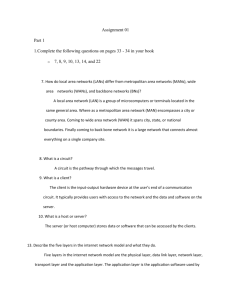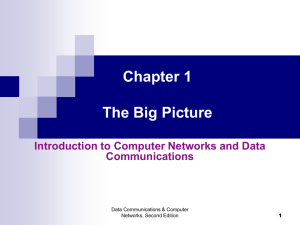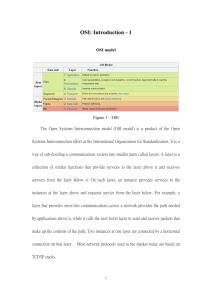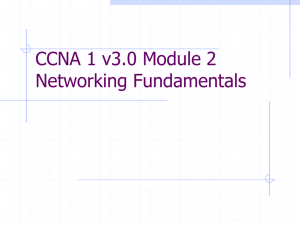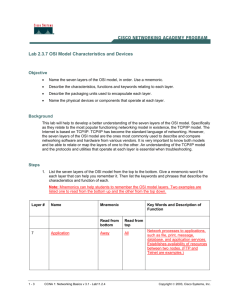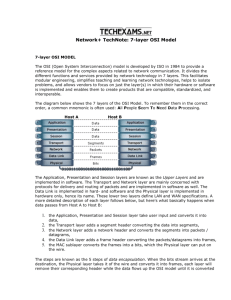Network Models and Their Impact on the Internet
advertisement
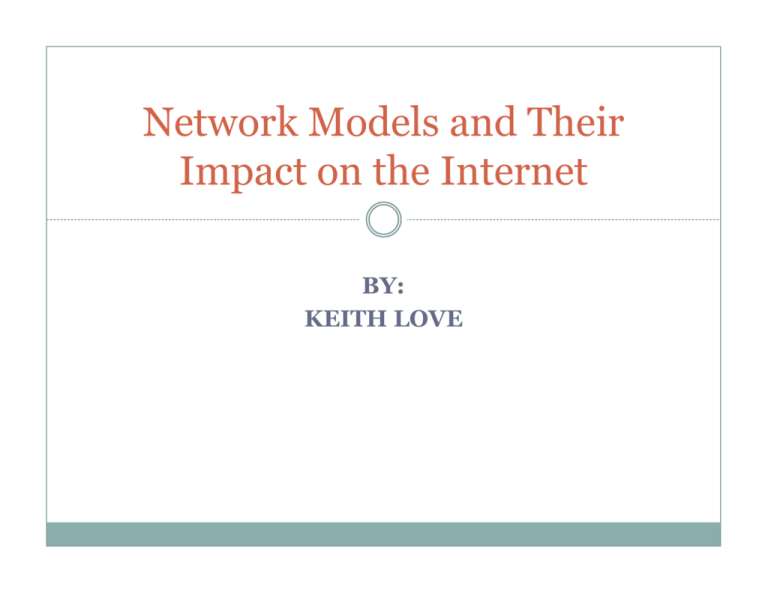
Network Models and Their
Impact on the Internet
BY:
KEITH LOVE
Introduction
y The Internet
{ What is it?
{ History
y Communication Networks
{ Components
{ Types
y OSI Model
{ History
{ Layers
y Internet Model
{ History
{ Layers
The Internet
y
y
y
y
What is it?
Connection of computers around the world
Uses protocols
Use email, IM, news groups
Not the World Wide Web
Internet vs. Web
Internet
y Access networks
y TCP/IP protocol
y Doesn’t directly use
browsers
Web
y Access information
y HTTP protocol
y Directly uses browsers
Internet History
y 1957: Soviet Union launches Sputnik
y 1969: ARPANET is created
y First successful communication of universities is
between University of California and Stanford
Research Institute
y First networking protocol: Networking Control
Program
y 1985:
{
{
NCP changes to TCP/IP
ARPANET splits into two
History (cont.)
y 1986: NSFNET created to connect universities
y 1989: 200,000 servers on Internet
y 1990s:
{ foreign countries use same standards as U.S.
{ Competing online services allow commercial servers for a fee
Internet Milestones
Originally called ARPANET,
the Internet began as a
military-academic network
1969
NSFNet created
as US Internet
backbone
1983
ARPANET splits:
• Milnet - for military
• Internet - academic,
education and research
purposes only
1986
commercial
access to the
Internet begins
1990
1994
Government
funding of the
backbone ends
2007
Worldwide: Over
1 billion Internet
users
Communications Networks
y Data communications – movement of computer info.
from one point to another
y Collect data from computer and transmit it to central
server
y Provide faster information flow
Network Components
y Three main parts
y Server (host computer)
{ Stores data that can be accessed by the clients
{ Servers can work together with the client
y Client
{ The input-output device at user end of communication circuit
{ Provides users with access to network and data on the server
y Circuit
{ Pathways which messages travel
{ Copper wire. Fiber-optic & wireless are growing in popularity
Network Types
y Local Area Network (LAN)
{ Group of computers located in same area Ex. Room, building
{ Computers share a circuit
y Backbone Networks (BN)
{ Larger central network that is usually a few kilometers large
y Metropolitan Area Network (MAN)
{ connects LANs and BNs located in different areas
{ provides fast transmission but can be costly for companies
y Wide Area Network (WAN)
{ connects BNs and MANs
{ does the same thing as a MAN except on a wider scale
Types (cont.)
y Intranet
{ LAN that uses the same technology as internet, but it is only
allowed to members within the organization
{ Ex. A company needs to share related information without
wanting it to be public
y Extranet
{ It is open to only the people outside of the organization
{ Ex. The company wants people outside of the corporation to
view information about them without knowing everything they
do
Open Systems Interconnection Model
y First brought about in the late 1970s by the
International Organization for Standardization
y 1984: The OSI Model was finally introduced
y The OSI never caught on commercially in North
America
y This model created seven layers
The Seven Layers
y 1. Physical Layer - Defines how individual bits are
formatted to be transmitted through the network.
2. Data Link Layer - Deals with message delineation,
error control and network medium access control.
y 3. Network Layer – Is responsible for making routing
decisions.
y 4. Transport Layer - Deals with end-to-end issues such
as segmenting the message for network transport, and
maintaining the logical connections between sender and
receiver.
y
Seven Layers (cont.)
5. Session Layer - Initiates, maintains and terminates
each logical session between sender and receiver.
y 6. Presentation Layer - Formats data for presentation
to the user and provides data interfaces, data compression
and translation between different data formats.
y 7. Application Layer – Is a set of utilities used by
application programs.
y
Internet Model
y similar to the OSI Model
y It was formed first but the OSI Model gained more
recognition and was more widely talked about
y Same layer concepts
y Different than OSI Model
y became the accepted standard and gained more
popularity by hardware and software vendors in the
U.S.
Internet Model (cont.)
y The main difference is the number of layers
y Has 4-5 layers depending on who you talk to
The Five Layers
y 1. Physical Layer - Defines how individual bits are
y
y
y
y
formatted to be transmitted through the network.
2. Data Link Layer - Deals with message delineation,
error control and network medium access control.
3. Network Layer - Is responsible for making routing
decisions.
4. Transport Layer - Responsible for establishing
end-to-end connections, translates domain names into
numeric addresses and segments messages.
5. Application Layer – Combines session,
presentation, and application layers of OSI Model.
Conclusion
y Overall, the internet, communications network, and
network models all play important roles in each
other’s existence.
y They all rely on each other in one way or another.
y In the comparison of the OSI Model vs. the Internet
Model, both models are fairly similar except for a few
layers that have been reorganized.



